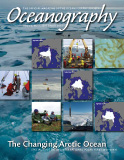Article Abstract
The Arctic Ocean is a potentially important sink for atmospheric carbon dioxide (CO2) with a recent estimate suggesting that the region contributes from 5 to 14% of the global ocean’s net uptake of CO2. In the western Arctic Ocean, the focus of this paper, the Chukchi Sea is a strong ocean sink for CO2 that is partially compensated for by outgassing of CO2 from the East Siberian Sea shelf. The Arctic marine carbon cycle and exchange of CO2 between the ocean and atmosphere appear particularly sensitive to environmental changes, including sea ice loss, warming, changes in seasonal marine phytoplankton primary production, changes in ocean circulation and freshwater inputs, and even the impacts of ocean acidification. In the near term, further sea ice loss, increases in phytoplankton growth rates, and other environmental and physical changes in the Arctic are expected to cause a limited net increase in the uptake of CO2 by Arctic surface waters. Recent studies suggest that this enhanced uptake will be short lived, with surface waters rapidly warming and equilibrating with the atmosphere. Furthermore, release of large stores of carbon from the surrounding Arctic landmasses through rivers into the Arctic Ocean and further warming over the next century may alter the Arctic from a CO2 sink to a source over the next century.

